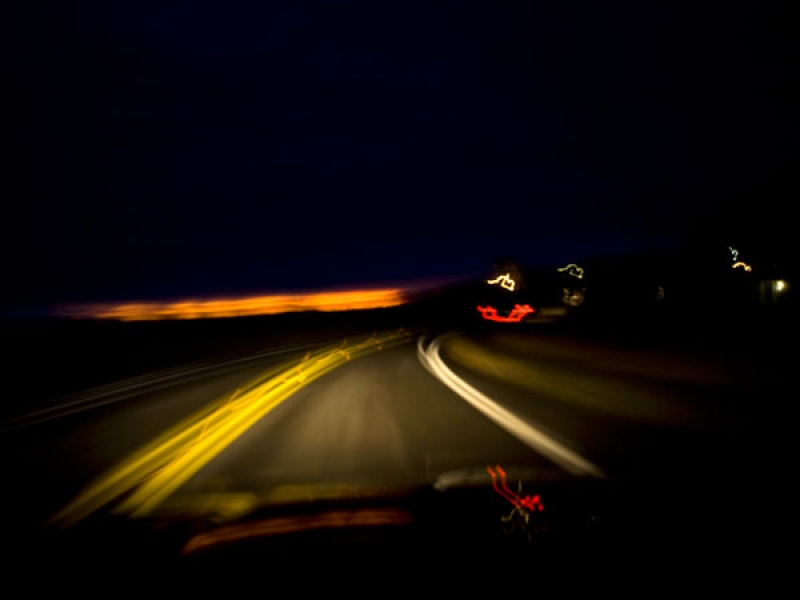Plenty of us hate night driving—there's no feeling quite like getting someone else's high beams shined in your eyes. But beyond the pure annoyance, few of us realize how dangerous it can be. Fatalities on the road occur at a rate three times greater at night than during the day, according to the National Highway Traffic Safety Administration. While only a quarter of all driving is done at night, more than half of all driving deaths occur then.
Your depth perception, ability to distinguish color, and peripheral vision are all worse in low-light conditions. You tend to be more tired at night. And consider a basic fact: Typical low beams illuminate the road from 160 to 250 feet in front of your car, and normal high beams shine from about 350 to 500 feet. At 60 mph it takes more than 200 feet to stop. So even with your high beams on, there's not a lot of room for error.
But we can't just sit around waiting for the sun to come up. Here are 10 tips to keep you safe on the road when the sun goes down.
Aim Your Headlights
We've found that headlights even in brand-new trucks are sometimes uneven or pointed lower than necessary. So it's worth the effort to
aim them correctly. If you do it yourself, use the instructions in your owner's manual. And be patient. It may take a few tries before you have them pointed perfectly. Just make sure those newly aimed lights are not blinding oncoming traffic.
Dim Your Instrument Panel and Dash Lights
Trucks come with dashboard dimmer switches for a reason. If you're driving around with the dash light on max, you could be compromising your forward vision. Racers take the nighttime driving very seriously—in fact, endurance racers and rally drivers cover their dashboards with black felt to avoid stray reflections. While you shouldn't do that in a road car, we like to turn down the dash brightness quite a bit.
And don't leave your map lights on. Less-expensive interior lights will disperse light all over the interior and shine into the driver's eyes, too. As good as your map lights may be, it's best to avoid driving with them on.
Don't Wear the Wrong Glasses
Have you seen ads proclaiming that yellow-tint sunglasses will help you see better at night? Don't believe them. The Sunglass Association of America says that yellow-lens glasses sold for night driving only make you think you see better.
The thought behind these glasses is that they might enhance contrast, helping you to distinguish objects in the dark. In reality, these hokey glasses actually cut down on the amount of light you can see. The smart choice is to use prescription glasses that have an anti-reflective coating, which keeps light from bouncing around inside your lenses. And as a bonus, these glasses have been shown to allow more light in.
Even if you're on an '80s music kick, it's best to avoid sunglasses at night—or any glasses, if you don't need them for vision correction. The sunglass industry folks say you'll see the most light without glasses—antireflective coated or not.
Become a Retina Spotter
On dark country roads, animals are everywhere. An encounter between wildlife and your car can be devastating—to you, the beastie, and certainly your vehicle. But here's a trick: You can often see the reflections of your headlights in an animal's eyes long before you can see the animal itself. Pairs of tiny bright spots in the distance are a clear warning that an animal is in front of you down the road.
The best strategy when encountering large animals like deer: Slow down as quickly as you can. If you try to steer around a deer, they often will follow your lights and move in front of you.
Don't Stare at Oncoming Lights
Bright lights can seriously disrupt your concentration at night. Inside the car, your eyes are used to the dim glow of the instrument panel and the dark road ahead. It's very easy to become distracted and stare into a bright road sign or the headlights of an 18-wheeler headed your way without even realizing it. Turn your gaze away from other lights on the road, and don't look at oncoming high beams. Even though you may sometimes find yourself trying to determine if that oncoming car's high beams are on, or if they're just mis-aimed, look away. If a car behind you has its high beams on, often you can move your rearview mirror to reflect light backward to alert the driver, and to get the reflection away from your own eyes.
Clean and Adjust Your Exterior Mirrors
Dirty mirrors reflect the lights from cars behind you in a wider, diffused shape that can produce glare in your eyes, so clean them up. Also, aim the exterior mirrors so that you can move your head out of the path of lights reflected in them. We like to aim them downward just slightly. That way, you can see cars behind you by tipping your head slightly forward, but you keep the other vehicle's headlights out of your eyes—and prevent them from temporarily blinding you with their high beams.
Also don't forget to switch your inside rear-view mirror to the Night or Auto Dim setting, which darkens the mirror to prevent glare.
Keep Your Eyes Healthy
To reduce the effects of eye fatigue at night while driving, eye doctors often recommend keeping your eyes moving, scanning all around your field of vision instead of focusing on one area. The American Optometric Association suggests checkups every three years if you're under 40, every two years until you're 60, and annually after that.







